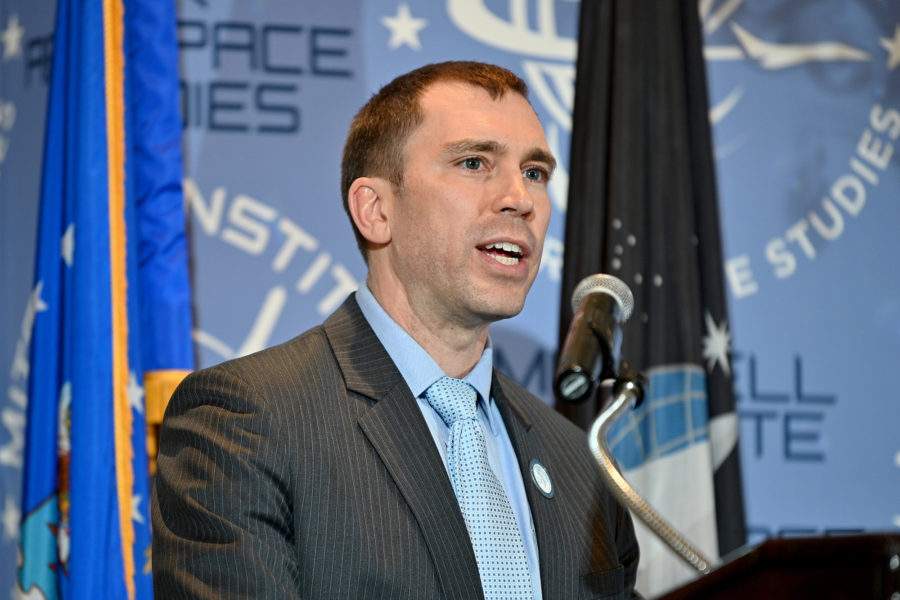Derek M. Tournear, the head of the Space Development Agency that spearheaded the trailblazing push to buy and launch small satellites at a speed and scale unseen in military space circles, is departing the organization for a job in academia just before a momentous launch.
Tournear, SDA’s first permanent director, is heading to Auburn University to become its first-ever “director of space innovation,” the school announced Sept. 8.
The move comes as SDA prepares to launch the first operational satellites in its Proliferated Warfighter Space Architecture for data transport and missile warning. The launch is scheduled for Sept. 10 from Vandenberg Space Force Base, Calif.
SDA has previously launched “Tranche 0” demonstration and proof-of-concept satellites, so deploying Tranche 1 operational spacecraft marks a pivotal test for SDA and its ground-breaking acquisition approach to buying hundreds of satellites in two-year cycles—before even the preceding tranche is launched.
Tournear, in a message on LinkedIn, compared his departure to bringing his daughter to college.
“Just like launching a child into college, I am now launching SDA into the next chapter,” he wrote. “I have confidence that SDA and the #SemperCitius mindset will continue to thrive, redefine impossible, and deliver for the warfighter!”
Tournear touted SDA’s successes during his six years in charge: most importantly awarding contracts for more than 470 satellites—far more than the Space Force’s entire satellite inventory today. The resulting proliferated constellation in low Earth orbit is designed to provide global coverage and to deter adversaries’ temptation to attack space assets by providing a self-healing constellation too large to easily take out.
SDA launched 27 satellites as part of Tranche 0, going from contract award to first launch in two and a half years. Those satellites demonstrated Link 16 radio transmissions from space, successful laser communications between two different vendors and down to both ground and airborne receivers on Earth, and tracked missiles from low-Earth orbit, all Pentagon firsts.
Yet Tournear acknowledged that his time at SDA was at times “tumultuous.”
The agency faced resistance from other Pentagon agencies as it unleashed a new rapid acquisition approach and pushed for a proliferated constellation in LEO, an orbital regime the U.S. military has not used extensively in the past.
“At the time of SDA’s establishment, many thought that [proliferated LEO] was a terrible idea,” Tournear wrote. “Convincing detractors of the virtues offered by pLEO was not easy, but through several major wins … the tide shifted. Now, SDA is not alone pushing for pLEO; this concept has been adopted and advocated by the Space Force at large, and incorporated into almost every mission area.”
Now SDA faces growing pressure to translate those early successes into operational wins.
Former assistant secretary of the Air Force for space acquisition Frank Calvelli, in an interview with Breaking Defense in January, said “the Tranche 1 launches … will be the make-or-break moment for the Space Development Agency.”
“If Tranche 1 launches, the satellites work as designed, and the capabilities are used by the operational community, then it’s a success,” Calvelli said. “If not, the issue will not be the use of small satellites, but something with the SDA acquisition approach that will need to be reassessed.”
With the change in administrations that month, the Pentagon ordered an “independent review” of SDA’s “health,” and said it would consider whether SDA will remain a semi-independent organization or should be absorbed into other Space Force offices. The Government Accountability Office released a report in February, critiquing the agency for investing so heavily in satellites with laser communications technology before fully proving out its operational effectiveness.
Tournear himself was briefly put on administrative leave this year amid an investigation into a disputed contract, which eventually resulted in the deal being cancelled and recompeted, and in Tournear being reinstated.
Future “Tranche 3” data transport satellites are on hold; the Department of the Air Froce 2026 budget request proposes pausing funding while officials consider one or more commercial solutions.
Even the upcoming launch has been a source of tension due to multiple delays officials have blamed on supply chain issues. The goal now is to start launching Tranche 1 satellites with a regular cadence, possibly as often as once per month.


